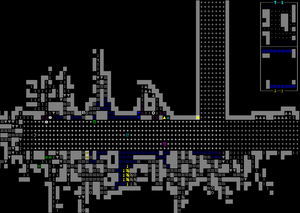- v50 information can now be added to pages in the main namespace. v0.47 information can still be found in the DF2014 namespace. See here for more details on the new versioning policy.
- Use this page to report any issues related to the migration.
Difference between revisions of "Tunnel"
Brightgalrs (talk | contribs) |
m (updated setting link) |
||
| (4 intermediate revisions by 3 users not shown) | |||
| Line 1: | Line 1: | ||
| − | {{ | + | {{migrated article}} |
| + | {{Quality|Unrated}} | ||
| + | {{av}} | ||
| − | [[ | + | [[File:DF tunnel.png|thumb|300px|An underground tunnel in the caverns with stairs leading down to a mountain halls. Ahead the way splits off to other dwarven sites under the mountains.]] |
| − | |||
| − | + | A '''tunnel''' is an underground [[dwarf|dwarven]] construction that connects generated [[fortress]]es and [[mountain halls]] together. | |
| − | + | On maps tunnels are represented by black dashed lines or grey double lines in ASCII mode. The name of the tunnel may be seen when mousing over it on the embark map. There are both a [[Settings#Embark|setting]] and an [[Advanced_world_generation#Allow_Init_Options_to_Show_Tunnels|advanced world generation]] option to prevent the display of them on maps. | |
| − | In [[ | + | Tunnels are paved with [[rock]] [[block]] [[floor]]s with [[ramp]]s at elevation changes. They are located in the first [[cavern]] layer, and the sides are frequently open to the caverns. |
| + | |||
| + | Fortresses can be [[embark]]ed over tunnels. The tunnels are open at the edges of the embark, allowing easily accessible [[fun]], but they can be blocked off by constructing [[wall]]s and/or raising [[bridge]]s. | ||
| + | |||
| + | Tunnels are the most convenient way for [[adventure mode|adventurer]]s to travel underground. Fast travel is allowed along them, unlike other underground areas. They may provide a path between dwarven mountain halls and the surface via fortresses. | ||
| + | |||
| + | Tunnels are built during the [[world generation]], like [[road]]s. In [[legends]], viewing the history of dwarven civilizations will mention tunnels they've constructed. Tunnel names will include words like ''cave'', ''deep'', ''passage'', ''corridor'', and ''hall''. Unlike roads, there are not separately constructed or named bridges. | ||
{{Translation | {{Translation | ||
Latest revision as of 06:37, 26 June 2023
| This article was migrated from DF2014:Tunnel and may be inaccurate for the current version of DF (v50.14). See this page for more information. |
v50.14 · v0.47.05 This article is about the current version of DF.Note that some content may still need to be updated. |
A tunnel is an underground dwarven construction that connects generated fortresses and mountain halls together.
On maps tunnels are represented by black dashed lines or grey double lines in ASCII mode. The name of the tunnel may be seen when mousing over it on the embark map. There are both a setting and an advanced world generation option to prevent the display of them on maps.
Tunnels are paved with rock block floors with ramps at elevation changes. They are located in the first cavern layer, and the sides are frequently open to the caverns.
Fortresses can be embarked over tunnels. The tunnels are open at the edges of the embark, allowing easily accessible fun, but they can be blocked off by constructing walls and/or raising bridges.
Tunnels are the most convenient way for adventurers to travel underground. Fast travel is allowed along them, unlike other underground areas. They may provide a path between dwarven mountain halls and the surface via fortresses.
Tunnels are built during the world generation, like roads. In legends, viewing the history of dwarven civilizations will mention tunnels they've constructed. Tunnel names will include words like cave, deep, passage, corridor, and hall. Unlike roads, there are not separately constructed or named bridges.
"Tunnel" in other Languages
|
Worlds | |||||||||
|---|---|---|---|---|---|---|---|---|---|
| General | |||||||||
| Map |
| ||||||||
| Civilization |
| ||||||||
